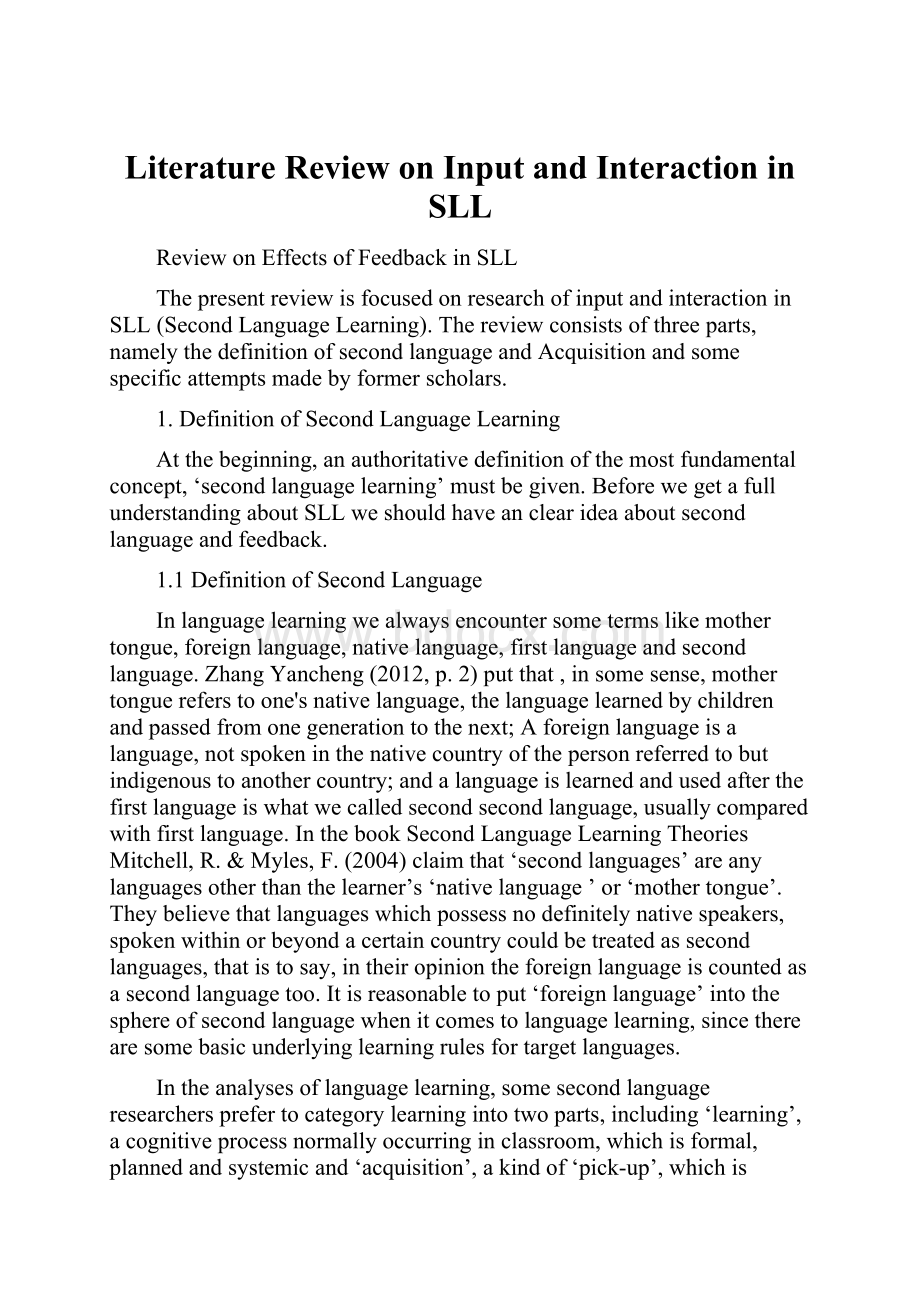Literature Review on Input and Interaction in SLL.docx
《Literature Review on Input and Interaction in SLL.docx》由会员分享,可在线阅读,更多相关《Literature Review on Input and Interaction in SLL.docx(12页珍藏版)》请在冰豆网上搜索。

LiteratureReviewonInputandInteractioninSLL
ReviewonEffectsofFeedbackinSLL
ThepresentreviewisfocusedonresearchofinputandinteractioninSLL(SecondLanguageLearning).Thereviewconsistsofthreeparts,namelythedefinitionofsecondlanguageandAcquisitionandsomespecificattemptsmadebyformerscholars.
1.DefinitionofSecondLanguageLearning
Atthebeginning,anauthoritativedefinitionofthemostfundamentalconcept,‘secondlanguagelearning’mustbegiven.BeforewegetafullunderstandingaboutSLLweshouldhaveanclearideaaboutsecondlanguageandfeedback.
1.1DefinitionofSecondLanguage
Inlanguagelearningwealwaysencountersometermslikemothertongue,foreignlanguage,nativelanguage,firstlanguageandsecondlanguage.ZhangYancheng(2012,p.2)putthat,insomesense,mothertonguereferstoone'snativelanguage,thelanguagelearnedbychildrenandpassedfromonegenerationtothenext;Aforeignlanguageisalanguage,notspokeninthenativecountryofthepersonreferredtobutindigenoustoanothercountry;andalanguageislearnedandusedafterthefirstlanguageiswhatwecalledsecondsecondlanguage,usuallycomparedwithfirstlanguage.InthebookSecondLanguageLearningTheoriesMitchell,R.&Myles,F.(2004)claimthat‘secondlanguages’areanylanguagesotherthanthelearner’s‘nativelanguage’or‘mothertongue’.Theybelievethatlanguageswhichpossessnodefinitelynativespeakers,spokenwithinorbeyondacertaincountrycouldbetreatedassecondlanguages,thatistosay,intheiropiniontheforeignlanguageiscountedasasecondlanguagetoo.Itisreasonabletoput‘foreignlanguage’intothesphereofsecondlanguagewhenitcomestolanguagelearning,sincetherearesomebasicunderlyinglearningrulesfortargetlanguages.
Intheanalysesoflanguagelearning,somesecondlanguageresearchersprefertocategorylearningintotwoparts,including‘learning’,acognitiveprocessnormallyoccurringinclassroom,whichisformal,plannedandsystemicand‘acquisition’,akindof‘pick-up’,whichisinformalandarbitrary.Inthepresentreview,itisdifficulttomakeanabsolutedivisionbetween‘learning’and‘acquisition’.Insomewell-writtendocumentslikeLinguistics--ACourseBookauthoredbyHuZhuanglin(2010)andSecondLanguageLearningTheories(mentionedabove),theyusebothtermsinterchangeably.Thereforethepresentreviewdoesnotmakeadistinctionbetween‘learning’and‘acquisition’.
Ifwedecodetheterm‘secondlanguagelearning’literally,itmeanstolearnsecondsecondlanguage,andthereareseveralmodesaboutsecondlanguagelearning,forinstance,theAcculturationModel(Brown,1980a),theNativizationModel(Anderson)andTheMonitorModel,however,Mitchell,R.&Myles,F.(2004)makeaspecificanddetailedconnotationasfollows:
“...toincludethelearningofanylanguage,toanylevel,providedonlythatthelearningofthe‘second’languagetakesplacesometimelaterthantheacquisitionofthefirstlanguage.(Simultaneousinfantbilingualismisaspecialisttopic.)”
(MitchellandMyles,2004,p.5)
1.2DefinitionofFeedback
TheconceptionoffeedbackisrelatedtotwoHypothesis,TheInputHypothesis(Krashen)andInteractionhypothesis(Long).
TheInputHypothesisisdevelopedbyabsorbingtheideaofcomprehensibleinputwhichintermsofsyntaxisjustbeyondthelearner’spresentanalyzingcapability.Morevividlyifalearner’spresentcompetenceisnthencomprehensibleinputisn+1.KrashenmaketheInputHypothesisthecoreofhisresearch:
“Speakingisaresultofacquisitionandnotitscause.Speechcannotbetaughtdirectlybut‘emerges’onitsownasaresultofbuildingcompetenceviacomprehensibleinput.”
(Krashen,1985,p.2)
Long’sInteractionhypothesisisthedevelopmentofKrashen’sInputhypothesis.Inordertofinishedhisdoctoralthesis,Longconductedadyadicresearchinvolving32nativespeakersand32non-nativespeakers.Long'sinteractionhypothesisstatethatlanguageacquisitioniswellimprovedbytheuseofthetargetlanguageininteraction.Duringtheinteractionthelearnershouldpayattentiontothesyntaxaswellasthesemantics,whichwillbeagrandchallengeforthem.Butinordertoachievethecommunicationgoal,thenativespeaker--non-activespeakerpairshaveadoptedsomecommunicationstrategies.SoLongbelievesthatcomprehensibleinputorcomprehensibleinteractionwillleadtolanguageacquisition:
Modificationoftheinteractionalstructureofconversation...isabettercandidateforanecessary(notsufficient)conditionforacquisition.Theroleitplaysinnegotiationformeaninghelpstomakeinputcomprehensiblewhilestillcontainingunknownlinguisticelements,and,hence,potentialintakeforacquisition.
(Larsen-FreemanandLong,1991,p.144)
BasedonInputhypothesisandInteractionhypothesis,feedbackisthenegotiationtacticssuchasrepetitions,confirmationchecks,comprehensionchecksorclarification.Thereforefeedbackistermedasareflectiontoalearner’sutterancethatcontainserrors(Ellisetal.,2006).Twomajortypesmakingupinteractionalfeedbackarerecastandelicitation.Arecast,thereformulationofalearner’sungrammaticalformbyateacher,isunobtrusiveanddoesnotinterruptthefluencyofcommunication(Trofimovichetal.,2007),whileelicitationisconsideredtobemoreobtrusiveandusuallyinterrupttheongoingconversationagainsttheirungrammaticalforms(Egi,2010;Sheen,2006).
2.PreviousStudiesonEffectsofFeedbackinSLL
Plentyofsecondlanguagelearningresearchersattachedmuchimportancetofeedback,whichcouldbedividedintotwoparts,includingtheearliermainlydescriptivepartwhichfocusedondocumentingtheexistenceofsuchfeedbackindifferentconversationalsittingsandthelaterempiricalpartwhichhadbeendevelopedtoexploretheunderlyingbenefitsofinteractionalfeedback.Byandlarge,thereviewcouldbedividedintotwoparts,thedescriptiveperiodandempiricalperiod.
2.1DescriptiveStudiesonEffectsofFeedbackinSLL
Inthepastthreedecades,attentionofresearcherswasdrawnontheroleofinteractionfeedbacklimitedinthefieldofSLA(SLAreferstosecondlanguageacquisition,andasmentionedintheformerpartthepresentstudydoesnotmakeadistinctionbetween‘learning’and‘acquisition’).AnumberofSLAresearchersprovedtheencouragingfunctionoffeedbackinSLA(Grass,2003;Gass,Makey,1998;Gass&Varonis,1994;Long,1996;Pica,1994,1996).Mitchell,R.&Myles,F.(2004)claimedbothfeedbacktypeshadbeensuggestedtocontributetoL2acquisitioninvariousways.
Interlocutor’srecastleadstoobviouscontrastbetweenlearners’utteranceandthetargetform,whichwillassistL2learning.ResearcherssuchasBohannonetal.(1990)andFarrar(1992)assertthatnegativeevidenceismuchmoreprevalentinchild-directedspeechthanwaspreviouslythoughtbyassertingthatcare-takers’recastofpoorlyformedchildutterancesofferimplicitnegativeevidenceaboutchildren’interimgrammaticalhypotheses.Atthattimewhethernegativeevidenceisessentialfortheacquisitionofcoreaspectsoflanguagestillremains“lessclear”,however(Mitchell,R.&Myles,F.,2004).
LongandRobinson(1998)argued,theprocessofaninterlocutorreconstructingalearner’serroneousutterancemaycatchthelearner’sattentiontothetargetformandsuggestthathisorherformmayderivefromthetheformal.Thus,suchfeedback,“drawslearners’attentiontomismatchesbetweeninputandoutput”andhence“causethemtofocusonform”(Long&Robinson,p.23).Thatistosay,recastmakesitpossibleforL2learnerorpushthemtofocusontheformaswellasthemeaningoftheiroutput.Atthesameresearchers,takingMackey&Phlip(1998)andMcDonough&Mackey(2000)asexamples,arguethatrecastalsomaysupplylearnerschanceofmodifyingtheiroutput.ThenfurtherstudyconductedbyDoughty(2001)andSwain(2005)stillhassuggestedthatrecastiscrucialforL2development.HoweverLyster&Ranta(1997)andOliver(1995)alsodoubttheeffectivenessofrecastmaybelimitedbyothertypesoffeedback.Long(2007)identifiedseveralseveraladvantagesforrecastsfromapsycholinguisticperspective.Heargued,wheninterlocutorsandlearnershaveasharedfocussphere,recastmayprovidelearnerswithmoreattentiontomodifytheirutterances’structuresincewhattheywanttoexpresshasbeencomprehended.Thus,recastcontextualizetheinformationneededaboutthetargetlanguage.Inaddition,recastsmayenhancewiththesalienceofthetargetformbyjuxtaposinganontargetlikeutterancewithatargetlikeutterance(Saxton,1997).ThisenhancementofsaliencemightincreasethepromotingeffectsofrecastsforL2development(Leeman,2003).
Incontrasttorecasts,elicitationisatypeofcorrectivefeedbackthatclearlyindicatestothelearnerthattheformisincorrectfollowedbytheprovisionofthecorrectformasin:
“NO,notX,itisY”.Thusthemajordifferencebetweenelicitationandrecastsisthatelicitationisself-evidentandthereforeenablesthelearnereasilytorecognizetheintentionoffeedbackandeventheirownerroneousoutput.Variousfunctionshavealsobeensuggestedforelicitationstrategies.Lyster(2001,2004)andLyster&Ranta(1997)claimedthatincludespossiblechanceofself-repair,promotingandautomatizingtherecalloftheformslearnersalreadyknow,andsupplylearnerswithchanceoftestandrevisetheirinterlanguesystemaboutthetargetlanguage.Andanumberofresearchershascometoanagreementthatelicitationcanalsoprovidelearnerschanceforpushedoutput.EspeciallySwan(1995,1998,2001,2005)arguedthatinorder